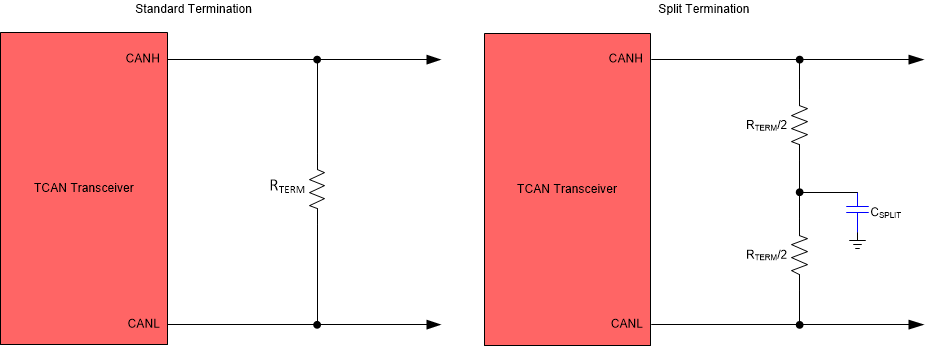ZHCSN78E january 2021 – march 2023 TCAN1043A-Q1
PRODUCTION DATA
- 1 特性
- 2 应用
- 3 说明
- 4 Revision History
- 5 Pin Configuration and Functions
-
6 Specifications
- 6.1 Absolute Maximum Ratings
- 6.2 ESD Ratings
- 6.3 ESD Ratings - IEC Specifications
- 6.4 Recommended Operating Conditions
- 6.5 Thermal Information
- 6.6 Power Dissipation Ratings
- 6.7 Power Supply Characteristics
- 6.8 Electrical Characteristics
- 6.9 Timing Requirements
- 6.10 Switching Characteristics
- 6.11 Typical Characteristics
- 7 Parameter Measurement Information
-
8 Detailed Description
- 8.1 Overview
- 8.2 Functional Block Diagram
- 8.3
Feature Description
- 8.3.1 Supply Pins
- 8.3.2 Digital Inputs and Outputs
- 8.3.3 GND
- 8.3.4 INH Pin
- 8.3.5 WAKE Pin
- 8.3.6 CAN Bus Pins
- 8.3.7
Faults
- 8.3.7.1
Internal and External Fault Indicators
- 8.3.7.1.1 Power-Up (PWRON Flag)
- 8.3.7.1.2 Wake-Up Request (WAKERQ Flag)
- 8.3.7.1.3 Undervoltage Faults
- 8.3.7.1.4 CAN Bus Fault (CBF Flag)
- 8.3.7.1.5 TXD Clamped Low (TXDCLP Flag)
- 8.3.7.1.6 TXD Dominant State Timeout (TXDDTO Flag)
- 8.3.7.1.7 TXD Shorted to RXD Fault (TXDRXD Flag)
- 8.3.7.1.8 CAN Bus Dominant Fault (CANDOM Flag)
- 8.3.7.1
Internal and External Fault Indicators
- 8.3.8 Local Faults
- 8.4 Device Functional Modes
- 9 Application Information Disclaimer
- 10Power Supply Recommendations
- 11Layout
- 12Device and Documentation Support
- 13Mechanical, Packaging, and Orderable Information
封装选项
机械数据 (封装 | 引脚)
散热焊盘机械数据 (封装 | 引脚)
- DMT|14
订购信息
9.1.3.1 CAN Termination
Termination may be a single 120-Ω resistor at each end of the bus, either on the cable or in a terminating node. If filtering and stabilization of the common-mode voltage of the bus is desired then split termination may be used, see Figure 9-2. Split termination improves the electromagnetic emissions behavior of the network by filtering higher-frequency common-mode noise that may be present on the differential signal lines.
 Figure 9-2 CAN Bus Termination Concepts
Figure 9-2 CAN Bus Termination Concepts